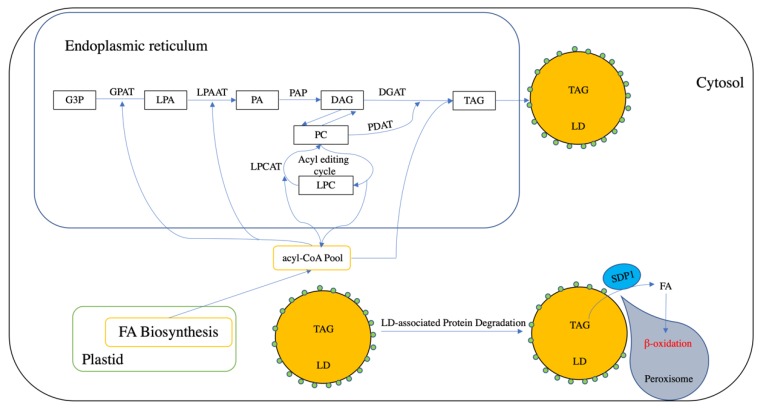Figure 1.
Brief Overview of triacylglycerol (TAG) biosynthesis, storage, and degradation in plants. Plastid provides a fatty acid (FA) pool, which can be transported into cytosol and activate into acyl-CoA. In the endoplasmic reticulum, G3P (glycerol 3-phosphate) can be acylated into lysophosphatidic acid (LPA) at the sn-1 position by using acyl-CoA as an acyl donor. Lyso-phosphatidic acid (LPA) can then be acylated with an acyl moiety from acyl-CoA pool and yield phosphatidic acid (PA) by acyl-CoA:lyso-phosphatidic acid acyltransferase (LPAAT). Phosphatidic acid phosphatase (PAP) is responsible for the dephosphorylation of PA into diacylglycerol (DAG). DAG can be directly acylated into TAG by diacylglycerol acyltransferase (DGAT). DAG also can be exchanged with phosphatidylcholines (PC). PC also can be generated through the acyl editing cycle, which involves the reacylation–acylation cycle. Additionally, acyl-CoA can be incorporated into PC by lysophosphatidylcholine acyltransferase (LPCAT). PC can be catalyzed by a phospholipid:diacylglycerol acyltransferase (PDAT) into TAG. Lipid droplets (LDs) is an organelle used for TAG storage, which is covered by a single layer of phospholipid- and LD-associated proteins (small green circles). The degradation of LD is initiated with the degradation of LD-associated proteins. Afterwards, peroxisome can interact with the LD and deliver a TAG lipase (sugar-dependent 1, SDP1) into the LD surface and hydrolysis TAG into FA and glycerol with the association of other lipases (not shown in this figure). FA is transported into peroxisome for β-oxidation.

